
Common Area Maintenance (CAM) reconciliation is a critical financial process in commercial real estate, ensuring that tenants pay their fair share of property maintenance costs. However, traditional CAM reconciliation is often time-consuming, error-prone, and administratively burdensome.
Artificial Intelligence (AI) is revolutionizing this process by automating data extraction, identifying discrepancies, and improving accuracy. AI-driven CAM reconciliation enhances efficiency, reduces disputes, and enables better financial forecasting. This article explores how AI can optimize CAM reconciliation, its key benefits, and the future of AI-driven lease expense management.
The Role of AI in CAM Reconciliation
1. Automating Data Processing with AI
One of the biggest challenges in CAM reconciliation is handling vast amounts of lease agreements, invoices, and financial records. AI-powered tools streamline this process by:
- Extracting CAM-related clauses from leases using Natural Language Processing (NLP).
- Scanning invoices with Optical Character Recognition (OCR) to digitize expense data.
- Classifying and categorizing expenses automatically to match them with tenant obligations.
By automating these processes, AI eliminates manual data entry errors and accelerates reconciliation timelines.
2. AI-Driven Error Detection and Anomaly Identification
AI enhances accuracy by identifying inconsistencies between estimated and actual CAM charges. Advanced machine learning models:
- Detect duplicate invoices and incorrect charges.
- Highlight anomalies in expense allocations based on historical patterns.
- Flag lease discrepancies where incorrect formulas or allocation rules are applied.
AI-powered reconciliation ensures that every charge aligns with contractual obligations, reducing disputes and financial risks.
3. Intelligent Expense Allocation
Traditional CAM reconciliation relies on static formulas and manual calculations, which can be prone to errors. AI improves this by:
- Dynamically adjusting expense allocations based on occupancy changes and lease amendments.
- Applying different calculation models (pro-rata, percentage-based, or fixed costs) automatically.
- Ensuring that each tenant is charged fairly based on real-time expense tracking.
With AI, property managers can ensure accurate and equitable CAM charge distribution without manual intervention.
4. Predictive Analytics for CAM Expense Forecasting
AI-driven predictive analytics enable property managers to forecast future CAM expenses, helping landlords and tenants plan their budgets effectively. AI can:
- Analyze historical data to predict seasonal fluctuations in maintenance costs.
- Incorporate inflation and market trends to refine CAM charge projections.
- Provide customized forecasts for each tenant based on their lease terms and usage patterns.
Predictive analytics reduces financial surprises and enhances strategic decision-making in lease management.
5. Enhancing Transparency and Dispute Resolution
Tenant disputes over CAM charges are common, often due to unclear cost breakdowns. AI improves transparency by:
- Generating automated reconciliation reports with detailed expense justifications.
- Maintaining digital audit trails that track every expense adjustment.
- Providing self-service portals where tenants can access CAM data, submit queries, and receive AI-driven responses.
With AI-driven reporting, tenants gain full visibility into CAM expenses, leading to fewer disputes and better landlord-tenant relationships.
Key Benefits of AI in CAM Reconciliation
1. Increased Efficiency
- Reduces reconciliation time by automating data processing.
- Eliminates redundant manual tasks.
- Accelerates lease compliance verification.
2. Improved Accuracy
- Minimizes human errors in data entry and calculations.
- Identifies discrepancies in real time.
- Ensures correct allocation of expenses.
3. Cost Savings
- Reduces administrative overhead by automating reconciliation workflows.
- Prevents revenue leakage due to incorrect CAM calculations.
- Lowers legal costs by reducing tenant disputes.
4. Better Tenant Relations
- Enhances transparency with clear and automated reporting.
- Ensures fair expense allocation.
- Reduces billing disputes, improving tenant satisfaction.
5. Regulatory Compliance
- AI ensures CAM reconciliation aligns with lease agreements.
- Maintains audit-ready records for financial and legal compliance.
- Reduces the risk of regulatory penalties.
Implementing AI-Powered CAM Reconciliation
1. Choosing the Right AI-Powered Solution
Selecting an AI tool for CAM reconciliation requires evaluating:
- Integration capabilities with lease management and accounting software.
- Machine learning accuracy in detecting anomalies and processing data.
- User-friendly reporting for landlords and tenants.
2. Data Integration and System Automation
For AI to work effectively, lease data, invoices, and property expenses must be integrated into a centralized platform. AI-driven solutions seamlessly sync with:
- Lease management systems (e.g., Yardi, MRI, LeaseQuery).
- Accounting software (e.g., QuickBooks, SAP, Oracle).
- Expense tracking tools to monitor real-time costs.
3. Training and Adoption
Successful AI implementation requires:
- Training teams on AI-driven reconciliation workflows.
- Gradual deployment with phased automation.
- Continuous monitoring to refine AI models based on real-world usage.
Future of AI in CAM Reconciliation
1. AI-Enabled Chatbots for Tenant Queries
AI-powered chatbots will provide real-time answers to CAM reconciliation-related questions, reducing administrative workload.
2. Blockchain Integration for Secure CAM Transactions
Blockchain will enhance transparency and security by recording immutable expense data, preventing disputes.
3. AI-Powered Lease Optimization
Advanced AI models will analyze lease structures to recommend cost-saving strategies for landlords and tenants.
4. Autonomous CAM Reconciliation
Future AI systems will fully automate CAM reconciliation, requiring minimal human intervention while ensuring complete accuracy.
AI is transforming CAM reconciliation, making it faster, more accurate, and transparent. By automating data processing, improving error detection, and enabling predictive analytics, AI reduces administrative burdens and enhances lease expense management.
As AI technology continues to evolve, property managers, landlords, and tenants will benefit from more efficient CAM reconciliation, fewer disputes, and greater financial predictability. Organizations that embrace AI-driven CAM reconciliation today will gain a competitive edge in the future of commercial lease management.


